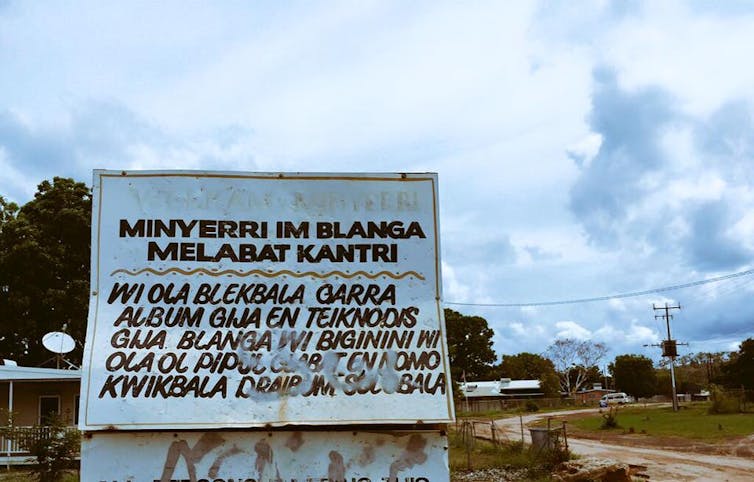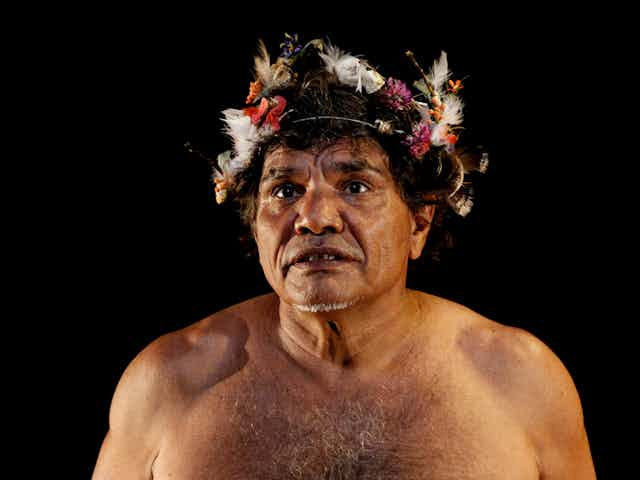It’s not a trivia question I’ve come across. But if someone asked: “which language, only found in Australia, is spoken over an area the size of Spain and is the second most common language in the Northern Territory?” would you get it right?
The correct answer – Kriol – is not a traditional Indigenous language, but refers to the creole language spoken across swathes of northern Australia. No one really knows how many people speak it, but the 2011 census figure of 4,000 is certainly an under-representation. Linguists put the number of Kriol speakers closer to 20,000, knowing that census data struggles to accurately capture high levels of multilingualism in remote Aboriginal communities.
Kriol is now even a language of Shakespeare. The critically acclaimed King Lear adaption The Shadow King (2013) was partially translated into Kriol by Aboriginal actor and musician Tom E Lewis (main image). It will debut internationally in London this June, coinciding with celebrations for Shakespeare’s 400th anniversary.
But what is Kriol? Well, Kriol is (not surprisingly) a creole language. Some may immediately associate the word “creole” with southern USA, which is home to French-influenced culture, cooking and language. But that association is a red herring.
Creole, as a linguistic term, is a type of language typically born out of abrupt and often brutal colonisation processes. Creoles are generally based on the dominant language of the colonisers, such as French (as in creoles spoken in Haiti, Louisiana or Mauritius), English (as in Solomon Islands, Belize or Hawai'i), or even Portuguese (in Cape Verde).
The lexicon and grammatical structures of creole languages are largely derived from the dominant language, called the “lexifier”. But speakers of creole languages adapt and innovate upon the lexifier to such an extent that the creole becomes incomprehensible to people who only speak the standard form of the lexifier.

The emergence of Kriol
The genesis of Northern Australia’s creole language is attributed to a combination of factors, including the expansion of the pastoral industry into the Northern Territory and Kimberleys, the violent frontier deaths that swiftly diminished the numbers of speakers of local Indigenous languages, and the establishment of missions.
At the Roper River Mission (now Ngukurr), established in 1908, Aboriginal children from various traumatised language groups were placed into dormitories with reduced parental contact. Bound together by a Pidgin English developed in New South Wales, they developed it into a fully-fledged creole: a language in its own right with a distinctive vocabulary, sound system and grammatical rules.
Over the course of a century, Kriol has spread or emerged in many other northern remote communities and where it has, it dominates daily life. English is usually reserved for dealings with white people and traditional languages so endangered they are barely heard.
In the fringes of Kriol country, some communities have recently created new languages, like Light Warlpiri and Gurindji Kriol, that systematically mix Kriol with the original language of the community.
The label Kriol is now used uncontroversially in many (but not all) places, but it took several generations to be legitimised. In the 1960s and 70s, linguists challenged the idea that creole languages were unsophisticated, lacking rules and a poor imitation of English.
Bible translation and academic research began to demonstrate that what was dismissed as Pidgin English was actually a language. The name Kriol was introduced and, fifty years later, it remains.
Gaining recognition
In legitimising the language, linguists and Kriol speakers showed that it was rule-governed and distinct from English. For example, Kriol speakers use the English word we (spelled wi) but the Kriol wi and English we are false friends. Kriol has finer distinctions and its speakers use four pronouns to cover what English speakers use only we for.
Sometimes, a word might be a recognisable English form, but the meaning is unique to Kriol. Drand, from “drowned”, simply means to go underwater. Death is not implied. Spilim, from “spill”, means to pour liquid intentionally. You can spilim ti to make your cuppa once the billy has boiled. But if you knocked it over, you might use the verb dilbak.
While most of Kriol’s lexicon is derived from English, words like dilbak, from traditional languages, make a small but important contribution to distinguishing Kriol further from English. In Ngukurr, you ngarra when you look surreptitiously. A few hundred kilometres away in Beswick, the word roih is used to describe the same thing. Words like roih and ngarra that differ based on geography also exemplify how different dialects have evolved across the large area where Kriol is spoken.
Kriol is a fully-functional, expressive language and can be used in all facets of life. Internationally, some creoles are national languages, as with Bislama in Vanuatu or Krio in Sierra Leone. Australia, with its monolingual mindset, has struggled to afford prestige to Kriol, as it has with traditional languages.
Despite this, in the space of fifty years, Kriol has gone from an unnamed creole, to a language that has been used in government education, liturgy, in stage and popular music, is interpreted widely, and now heard daily in ABC News.
The emergence and growing acceptance of Kriol is not without issues. Not everyone who a linguist would say is a Kriol speaker is comfortable applying that label to themselves. Kriol speakers typically place greater cultural importance and prestige on traditional languages, and those languages are declining rapidly.
For Aboriginal people who are concerned about the loss of traditional languages, Kriol is an obvious scapegoat, seen by more than a few as a language killer. Counter-arguments can be made that the same forces of colonisation and inequity have caused both phenomena: the loss of traditional languages and the emergence of Kriol.
Actor Tom E Lewis, who grew up speaking Kriol at the Roper River Mission, says Kriol is a “double-edged sword”:
We’re proud to speak Kriol. But it kinda backfired, because our [traditional] language is gone.
Whether you see Kriol as a positive or a negative, it deserves to be more widely known, if only because it is the largest language spoken exclusively in Australia. In its short history, it is now a significant part of Australia’s rich linguistic fabric. Kriol is a growing language, heard across much of Northern Australia, yet remains under-recognised and unfortunately is still sometimes stigmatised.
Greg will be on hand for an Author Q&A from 11am to noon AEST on Wednesday, 27 April 2016. Post any questions you have in the comments below.

